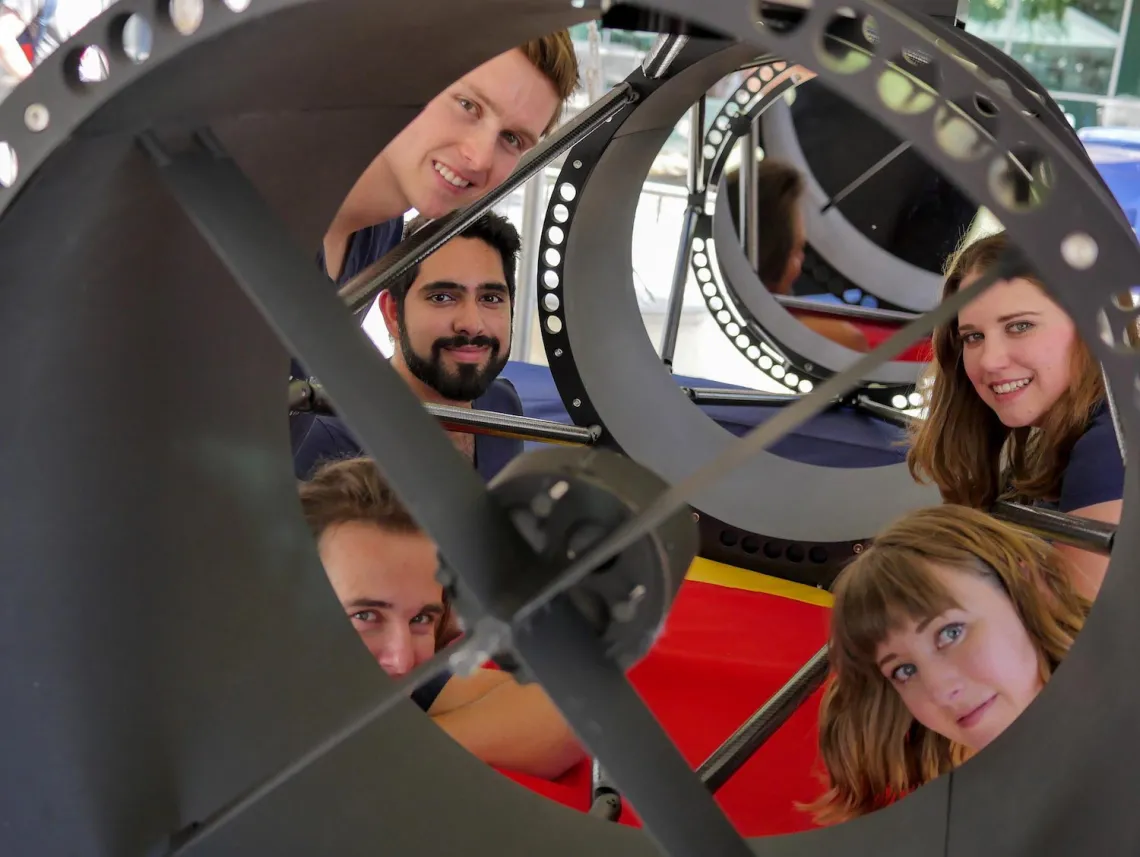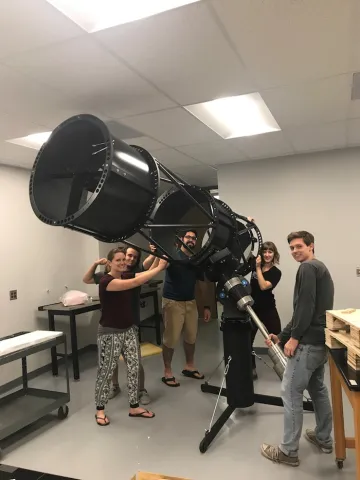Undergraduate Students Build Telescopes to Track Space Junk
Using less than a third of the money it’d take to buy them off the shelf, five UA undergraduates built two telescopes for satellite observation—one of which will live in a once abandoned observatory.

Why buy what you can make for yourself?
That’s the principle that drove five undergraduate students from the University of Arizona’s College of Engineering, led by Vishnu Reddy, to build two telescopes from the ground up to track satellites and space junk.
Reddy, an assistant professor of planetary sciences in the UA’s Lunar and Planetary Laboratory, joined the UA faculty eight months ago, offering expertise in space situational awareness. A large part of SSA involves tracking satellites and space junk around Earth. Federal entities such as the Department of Defense do so on a regular basis. It’s work that requires lots of observing time on small telescopes.
While the UA runs more than 20 large telescopes across the globe, very few of them are suited for tracking satellites. Having a telescope right on campus also provides an easy opportunity for students to access it without taking a long trip to Kitt Peak or Mount Lemmon. Reddy identified the perfect—and conveniently vacant—space for a small telescope. In the 1990s, a room on the sixth floor of the Kuiper building was transformed into a small observatory, complete with a retractable roof, so that Bob McMillan, Reddy’s colleague in the Lunar and Planetary Lab, could observe stars. The room was last used for observation in 1995, and later became a storage facility.
Instead of buying the telescopes off the shelf for upwards of $50,000 a piece, Reddy then recruited five undergraduate engineers to build them through the Engineering Design Program. The program, aimed at preparing them for careers in engineering, requires all engineering students at the UA spend their senior year designing, building, and testing technologies in teams of four to six, culminating in an annual Engineering Design Day.

Reddy’s team included Lindsie Jeffries, senior in biomedical engineering and mathematics; Sameep Arora, senior in mechanical engineering; Ryan Bronson, senior in optical sciences and mathematics; Damon Marco Colpo, senior in optical sciences and mathematics; and Evelyn Hunten, senior in electrical and computer engineering.
When asked if anything about the project surprised him, Reddy responded, unequivocally, “The students. Undergrads are some of the most optimistic people on campus. They’re full of life, they feel positive about the future, and they inspire me to be enthusiastic.”
“I love space science and exploration, so this project was obviously the one I wanted to work on. It was my first choice,” said Hunten, who will begin working at IBM shortly after graduation. “I love the instrumentation behind scientific discoveries.”
Together they built two 24-inch telescopes in seven months, and with just about $30,000 for both. The mirrors they installed in the new telescopes were recycled from the telescope in the old observatory—unused for 20 years—on the sixth floor of the Kuiper building. Labelled “junk,” these mirrors were otherwise headed straight for the UA’s Surplus Store.
Local astronomy business Starizona was instrumental in training the students and testing the telescopes’ optics, said Reddy.
Between mid-May and mid-June, one of the telescopes will be installed in the very place where the old one once stood, on the sixth floor of the Kuiper building. As of June 20, following a first light ceremony at 6:00 p.m., the telescope will run autonomously each night.
This will be the first time a telescope has been installed on campus since the 1990s. The location for the second telescope has yet to be determined, but the team has discussed Biosphere 2 as a possibility.
Arora, who designed the telescope model in SOLIDWORKS, said “making an actual product that will be used for science” rather than “just a prototype” was a rewarding experience.
“It was exciting putting the telescope together and confirming that everything fit and worked. I also enjoyed getting to know my teammates,” said Jeffries, who upon graduation will pursue a graduate degree in biomechanical engineering at Stanford University. “They were all hard workers who cared about the project and pushed me to do my best.”
While she and her teammates were building the telescopes, Reddy was writing a proposal to the AFRL, requesting funding for a spectroscopic survey of satellites in the geostationary orbit. Satellites in geostationary orbit revolve around Earth at the same rate as Earth rotates on its axis. This makes them hover above the same location on the Earth. Because their rotation matches ours—moving from west to east—they appear as fixed in space when we look at them from telescopes on Earth. More than 500 such satellites are in orbit today.
Rather than tracking satellites as mere nondescript dots in space—which is not uncommon—Reddy will be able to use the telescopes to identify some unique color signatures of satellites, to find out exactly which one is which.
“The UA is going to be a leader in space situational awareness, and we really want to capitalize on our exceptional undergraduate students,” said Reddy. “This is also workforce development. We need an American workforce that can rise to the challenges of our national security needs, and the needs of our nation.”

